🎣 Freight vs. Tariffs
Plus, two trucking firms close, harassment claims at TIA conference, a 19.5% week-over-week drop in spot loads, and more.
Ocean freight rates are rising due to supply constraints, route changes, and peak season prep. Here’s what’s driving the increases and what to expect next.

Ocean freight container rates are rearing up, and everyone’s feeling it. Here’s what’s driving these price hikes and what it means for the freight industry.
Xenta, the world's largest ocean and air freight rate benchmarking and market analytics platform, provided insights into why we're seeing the jumps.
Record Demand: Demand reached record levels in Q1 2024, up 9.2% compared to Q1 2023. Xeneta’s Senior Shipping Analyst Emily Stausbøll notes, "The speed at which it has happened has caused nervousness in the market."
Red Sea Crisis: The instability in the Red Sea is putting increased pressure on shipping capacity. Ships are rerouting around Africa, adding weeks to transit times and reducing available capacity.
Pandemic Lessons: The chaos of port congestion and lack of available capacity during COVID-19 is still fresh. Shippers are importing more now to avoid future delays. Stausbøll says, "If shippers fear there is going to be a squeeze on capacity during the peak season in Q3 then they are going to start importing more goods now."
Inventory Management: Many US shippers reduced inventories in 2023, making room for more imports now. "The risk of having too high inventories is more palatable than the risk of having goods arrive too late," says Stausbøll.
Global Instabilities: Ongoing issues like the Red Sea crisis, Panama Canal restrictions, and the US-China trade war contribute to market volatility. New US tariffs on Chinese imports and potential labor disputes on the US East Coast add to the uncertainty. Stausbøll warns, "Who can be confident in saying there isn’t going to be another black swan event in 2024?"
Spot vs. Long-Term Rates: While long-term rates have remained flat, spot rates are rising. Carriers are capitalizing on current demand to secure higher rates for immediate shipments. "Carriers have now mostly agreed new long-term contracts for the next 12 months at lower rates... If carriers are able to make money from shippers who want to use the spot market to frontload additional volumes ahead of peak season, then clearly they are going to take that opportunity," Stausbøll explains.
Replying to a post by @Molson_Hart, many speculated on why we're seeing this spike:

Artificial Supply Shortage: Twitter user @Mattdoll suggests that shipping lines are "parking" boats to create a supply shortage, driving prices up and causing shipment delays.
Route Adjustments: @marco_castelli mentions that the rerouting of ships around Africa due to instability has eliminated capacity days, acting like taking ships offline.
Peak Season: @ValueInvestJpn points out that excess inventory from Asia is now exhausted, leading to a retaking of usual volumes and potential peak season surcharges.
Demand and Supply: @Goolic highlights that the combination of pirates, canal restrictions, and port deactivations has created a less efficient system, leading to reduced ship availability and increased prices.
Bullwhip Effect: @arugmu attributes the price spike to the bullwhip effect, where the addition in overall transit time hits the supply again, creating a ripple effect in rates.
Expect continued volatility in ocean freight rates. Shippers will likely keep importing at higher rates to avoid delays, especially with potential new black swan events on the horizon. Stay informed and plan ahead to mitigate the impact of these rate spikes on your operations.
Sources: Xeneta | Drewry/Hellenic Shipping News
Join over 12K+ subscribers to get the latest freight news and entertainment directly in your inbox for free. Subscribe & be sure to check your inbox to confirm (and your spam folder just in case).